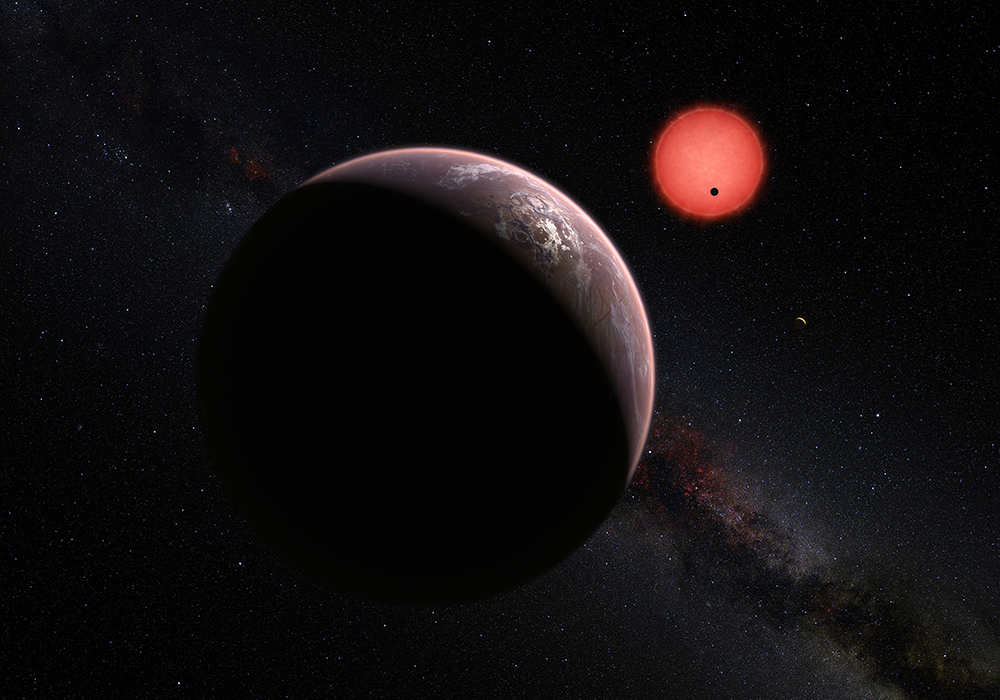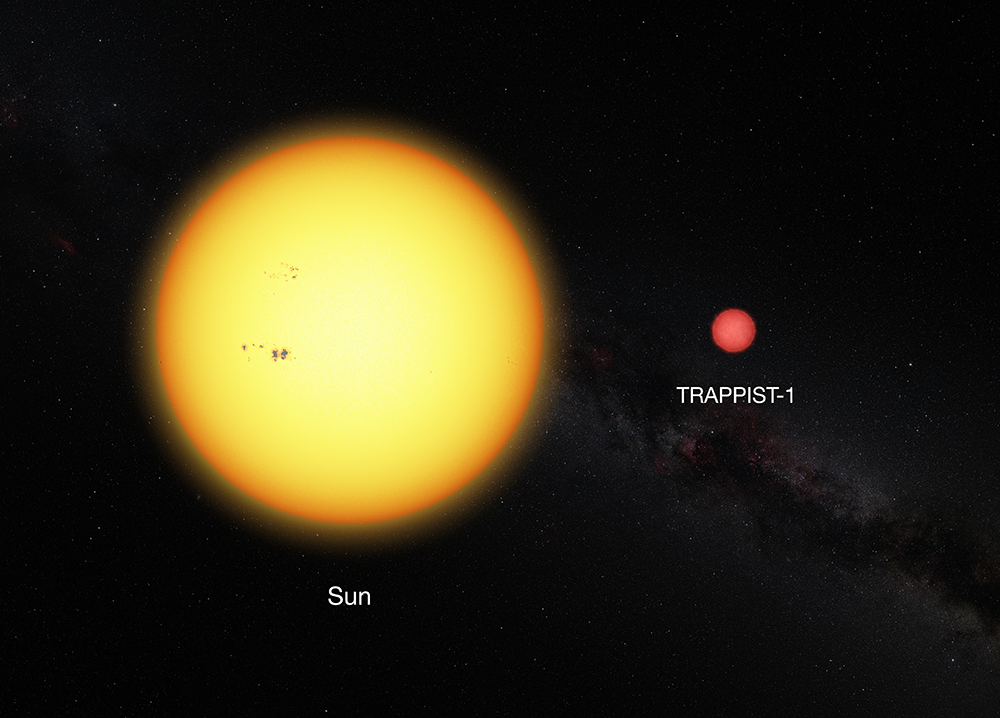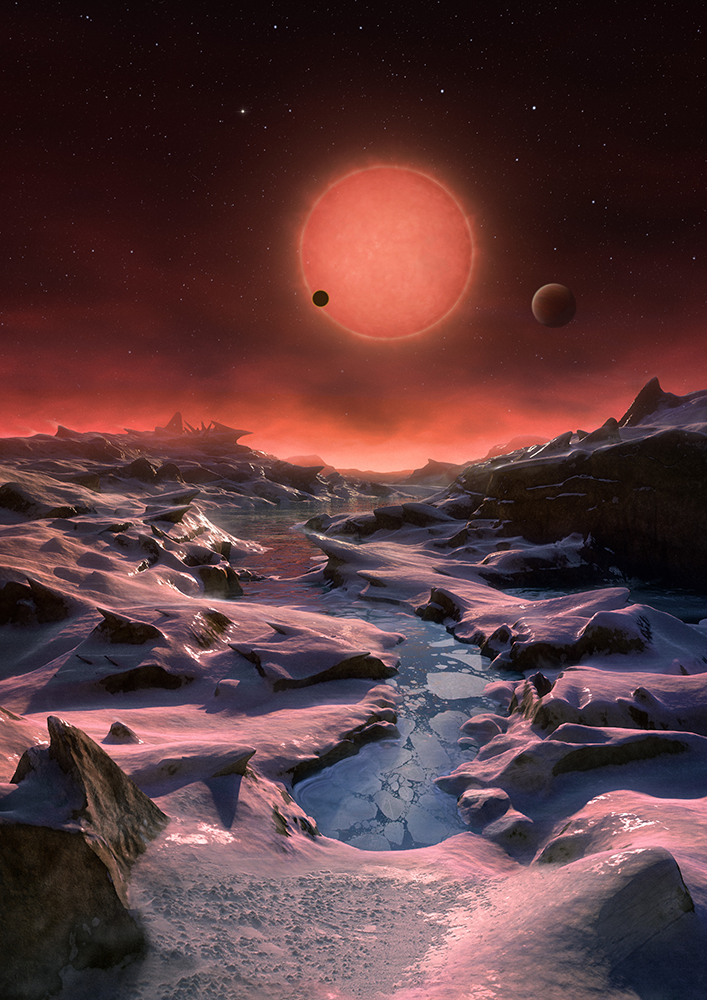PAOC Spotlights
When Searching for Habitable Exoplanets, Think Smaller Stars
A new planetary survey may have yielded our best chance for finding an Earth-like world yet.
***
The search for habitable, Earth-like worlds is one of the holy grails for astronomers. Worldwide, over 50 projects and missions have, at least in part, been combing the skies for exoplanets capable of harboring life. Many scientists have dedicated their lives to this endeavor and now for a group of astronomers, a big gamble on a novel project may have paid off.

Focusing on the constellation Aquarius, a unique telescope in Chile called TRAPPIST (TRAnsiting Planets and PlanetesImals Small Telescope) targeted a small, cool, dim star called 2MASS J23062928 − 0502285. TRAPPIST observed as light from the celestial body traveled 40 light-years into its lens. For 55 seconds at a time, the telescope measured the star’s luminosity. Then the star dimmed. Over sixty-two nights, the astronomers from MIT, the University of Liege and NASA watched as it did this another ten times. Something was partially eclipsing the star—now called TRAPPIST-1 after the telescope. The astronomers determined that these were transit events, the result of 3 orbiting planets.
But unlike the thousands of exoplanets found before them by Hubble and Kepler, this circumstance was special. These new planets were Earth-sized with the potential for an atmosphere and the existence of liquid water and life. Furthermore, they were orbiting an ultracool dwarf star—the smallest and coldest type of star—which theory postulated was improbable. But there they were. Published in the journal Nature, the group’s discovery might prove to be our best chance yet at finding another habitable planet close by and a reason to expand the field of search to a new class of planetary system revolving around ultracool dwarfs.
“This is very exciting,” said Julien de Wit, a postdoc in MIT’s Department of Earth, Atmospheric and Planetary Sciences and one of the members of the TRAPPIST team. “We’ve never found planets around such stars [ultracool dwarfs].”
The reason for this is that no one has really looked. When it comes to searching for planets capable of sustaining life, scientists historically gave priority to surveys centered on large, Sun-like stars. Because of their size, these stars are more likely to have Earth-sized planets orbiting them and have plenty of hydrogen to fuse into helium, which provides the necessary energy to the circling bodies. On the other end of the spectrum are ultracool dwarf stars like TRAPPIST-1. One-eighth the size of our Sun and a fraction as hot, 2,500 Kelvin rather than 6,000 Kelvin, ultracool dwarf stars emit lower energy radiation in the near-infrared, rather than in the visible spectrum like our Sun. Powered by infrared energy, life, if it exists, would look very different from ours, as photosynthesis would not be possible. For these reasons, ultracool dwarfs have been passed over for most exoplanet studies.
 But, when the goal is to find a nearby Earth-like planet, the astronomers decided to reason backwards—searching instead for planets that they could characterize. And the best chance for this was to look around the smallest, dimmest and coolest stars, “ultracool dwarfs”.
But, when the goal is to find a nearby Earth-like planet, the astronomers decided to reason backwards—searching instead for planets that they could characterize. And the best chance for this was to look around the smallest, dimmest and coolest stars, “ultracool dwarfs”.
"Why are we trying to detect Earth-like planets around the smallest and coolest stars in the solar neighborhood?" Michael Gillon, the TRAPPIST project leader with the University of Liege said in a statement. "The reason is simple: systems around these tiny stars are the only places where we can detect life on an Earth-sized exoplanet with our current technology. So if we want to find life elsewhere in the Universe, this is where we should start to look."
Our “current technology” allows us to deduce a lot about the planets themselves from transit events like those around TRAPPIST-1. As light travels from the star to the telescope, the planet interferes with the light’s trajectory—bending, scattering and blocking the beam—essentially sampling the planet as it makes its way. When analyzed, the resulting light can paint a portrait of the planet’s composition, size, atmosphere among other metrics, and different wavelengths indicate the presence of organic molecules or water.
But the strength and quality of this signal is proportional to the system’s host star. “The smaller the star, the better for us in terms of signal,” de Wit said. Think photography, as the light source gets smaller, the fine details become more pronounced. Large, bright stars drown out any signal from a transiting planet, but ultracool dwarf stars like TRAPPIST-1 provide just enough backlight for observation. “This [small star to planet ratio] is what enhances the signal, making these planets particularly suitable for characterization.”
Using the TRAPPIST telescope, the MIT and the University of Liege astronomers determined that the new worlds share a few qualities with the Earth. In addition to their similar size, the scientists believe that the planets called TRAPPIST-1b, TRAPPIST-1c and TRAPPIST-1d (inner to outer) are rocky and not composed of gas or ice. But unlike our solar system, the TRAPPIST one is compact, with orbital periods of 1.5 and 2.4 days, respectively, for the inner planets. Additionally, the lead researchers, Michael Gillon and Emmanuel Jehin of the University of Liege, believe that the two inner planets are tidally locked—like our moon to Earth—with one side perpetually facing the star and the other side in darkness. A present, these same metrics are not known about the furthest planet, 1d. So far, the astronomers have been able to conclude that the planet completes an orbit in as little as 4.5 days to as much as 73 days. 1d could also be tidally locked like its neighbors—spinning around its axis at the same rate as its orbit—or not.
 In stellar systems with a hot star, this combination of planetary proximity and fixed-orientation would be inhospitable. Adam Burgasser, a Professor University of California, San Diego and a member of the TRAPPIST team estimates that the inner planets receive four and two times, respectively, the radiation that Earth gets from the Sun. In this circumstance, the illuminated side would be scorching while the night side would be frigid. “But the thing is, this [ultracool dwarf] star is much cooler,” said de Wit. “So, even though they are close, they are not roasted, so it’s not an issue.”
In stellar systems with a hot star, this combination of planetary proximity and fixed-orientation would be inhospitable. Adam Burgasser, a Professor University of California, San Diego and a member of the TRAPPIST team estimates that the inner planets receive four and two times, respectively, the radiation that Earth gets from the Sun. In this circumstance, the illuminated side would be scorching while the night side would be frigid. “But the thing is, this [ultracool dwarf] star is much cooler,” said de Wit. “So, even though they are close, they are not roasted, so it’s not an issue.”
Still, for life—or at least water—to persist, all or part of these planets must fall into what exobiologists call “a goldilocks zone”. While many astronomers think that the layout of TRAPPIST’s system would inhibit this, modeling has shown that the presence of an atmosphere, if one exists and by extension weather, could transfer heat from the light to the dark side of the planets. The resulting habitable “belt” around the western boundary would be temperate and potentially able to support life on at least part of its globe, said de Wit. As for the outer-most planet, 1d, the fact that it’s further away from TRAPPIST-1 and perhaps not tidally locked could mean that it’s habitable on its whole globe, able to circulate heat and any organic molecules, if present.
While this is speculative, the TRAPPIST team along with MIT’s de Wit feels like they’ve struck exoplanet gold. “Yes there have been others [good exoplanet candidates before this], but for the first time, these are Earth-sized, temperate, nearby and ideally-suited for atmospheric study—a winning combination. These are potentially the very first habitat that we’ll be studying outside of the solar system. That’s the key thing. That’s exciting.”
Now the astronomers from MIT, the University of Liege must work out the planets’ finer details. Originally designed to search for new worlds around faint ultracool dwarf stars, the prototype telescope TRAPPIST was a $400,000 gamble that’s paid off, but that’s the extent of its function. It cannot further resolve the planetary features needed determine the trio’s habitability. That’s where Hubble, Spitzer and K2 step in. The Hubble and Spitzer Space Telescopes have begun conducting a preliminary assessment of the planets’ habitability—looking for signs of an atmosphere and water. Astronomers plan to observe TRAPPIST-1 system with K2 later this year in order to nail down the masses and densities of these exoplanets. But it's the next generation of large telescopes that will provide us with the most information, said de Wit. Slated to launch in 2018, the James Webb Space Telescope will be sensitive enough to scan the TRAPPIST-1 system in other energy ranges from x-rays to radio waves and detect specific molecules of interest like water, oxygen and methane. Equipped to infrared spectroscopy, the James Webb Space Telescope will be able to refine the TRAPPIST-1 observations further—determining the concentrations of these potential biomarker molecules and potentially their source, and constraining other planetary characteristics like temperature, pressure and composition of their atmospheres.
 In the meantime, the TRAPPIST team will continue to search for Earth-like worlds around ultracool dwarf stars with the survey, SPECULOOS (Search for habitable Planets EClipsing ULtra-cOOl Stars). Beginning soon, the program will examine 500 stars in both the Northern and Southern skies nearest to Earth. But unlike Kepler, which can observe 100,000 stars at a time, TRAPPIST and forthcoming similar telescopes can only look at one at a time. To some, this investment into ultracool dwarf stars may seem inefficient, but Adam Burgasser and his TRAPPIST team don’t see it that way."While such a 'cold' star might sound exotic, many, if not most, of the stars in our Milky Way Galaxy are of this cool, red, small and dim variety," he said in a statement. "If Earth-like planets around these stars turn out to be common, there may be many more habitable planets out there than current estimates predict." And that, de Wit said, is just the beginning.
In the meantime, the TRAPPIST team will continue to search for Earth-like worlds around ultracool dwarf stars with the survey, SPECULOOS (Search for habitable Planets EClipsing ULtra-cOOl Stars). Beginning soon, the program will examine 500 stars in both the Northern and Southern skies nearest to Earth. But unlike Kepler, which can observe 100,000 stars at a time, TRAPPIST and forthcoming similar telescopes can only look at one at a time. To some, this investment into ultracool dwarf stars may seem inefficient, but Adam Burgasser and his TRAPPIST team don’t see it that way."While such a 'cold' star might sound exotic, many, if not most, of the stars in our Milky Way Galaxy are of this cool, red, small and dim variety," he said in a statement. "If Earth-like planets around these stars turn out to be common, there may be many more habitable planets out there than current estimates predict." And that, de Wit said, is just the beginning.
***
Since the publication of the TRAPPIST team’s paper, NASA has announced that Kepler has found 1,284 new exoplanets. “This announcement more than doubles the number of confirmed planets from Kepler,” said Ellen Stofan, chief scientist at NASA Headquarters in Washington in a statement. “This gives us hope that somewhere out there, around a star much like ours, we can eventually discover another Earth.” NASA believes that of these, “nearly 550 could be rocky planets like Earth, based on their size. Nine of these orbit in their sun's habitable zone, which is the distance from a star where orbiting planets can have surface temperatures that allow liquid water to pool. With the addition of these nine, 21 exoplanets now are known to be members of this exclusive group.”
While impressed by the finding, MIT’s Julien de Wit still thinks that ultracool dwarf systems are still our best chance to find an Earth-like planet. These newly-discovered exoplanets are likely too far away from Earth to be characterized for signs of life, he expressed. “The planets found are of interest, but not in the context of atmospheric study, [and] habitability assessment.”
***
Postdoc Julien de Wit works with MIT’s Sara Seager, an astrophysicist and planetary scientist focusing on theory, computation, and data analysis of exoplanets. More on her group's work can be found here, in addition to a list of her publications.
This research was funded, in part, by the Belgian Fund for Scientific Research, the European Research Council, and NASA.